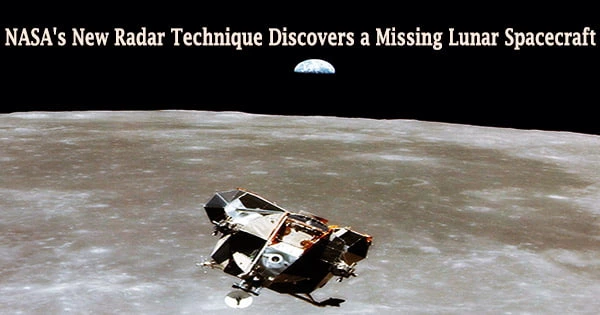It can be difficult to locate derelict spacecraft and space debris in Earth’s orbit due to technological limitations. It’s significantly more difficult to detect these objects in orbit around Earth’s moon. Optical telescopes cannot hunt for minuscule objects buried in the moon’s dazzling glare.
However, scientists at NASA’s Jet Propulsion Laboratory in Pasadena, California, have successfully discovered two active and dormant spacecraft orbiting the moon using a new technical application of interplanetary radar. This innovative method could aid future lunar mission planners.
“We have been able to detect NASA’s Lunar Reconnaissance Orbiter (LRO) and the Indian Space Research Organization’s Chandrayaan-1 spacecraft in lunar orbit with ground-based radar,” said Marina Brozovic, a radar scientist at JPL and principal investigator for the test project.
“Finding LRO was relatively easy, as we were working with the mission’s navigators and had precise orbit data where it was located. Finding India’s Chandrayaan-1 required a bit more detective work because the last contact with the spacecraft was in August of 2009.”
To make matters worse, the Chandrayaan-1 spacecraft is a cube roughly five feet (1.5 meters) on each side, nearly half the size of a smart car.
Even with the world’s most powerful radars, academics were not confident that an object of this modest size as far away as the moon could be discovered. Chandrayaan-1 was the ideal target for showing the technique’s capabilities.
While all radar transmitters employ microwaves, not all of them are made equal. The working range of the ordinary police radar gun is around one mile, while air traffic control radar has a range of about 60 miles.
We have been able to detect NASA’s Lunar Reconnaissance Orbiter (LRO) and the Indian Space Research Organization’s Chandrayaan-1 spacecraft in lunar orbit with ground-based radar. Finding LRO was relatively easy, as we were working with the mission’s navigators and had precise orbit data where it was located. Finding India’s Chandrayaan-1 required a bit more detective work because the last contact with the spacecraft was in August of 2009.
Marina Brozovic
JPL’s team used NASA’s 70-meter (230-foot) antenna at NASA’s Goldstone Deep Space Communications Complex in California to put out a powerful beam of microwaves focused at the moon to find a spacecraft 237,000 miles (380,000 kilometers) distant.
The 100-meter (330-foot) Green Bank Telescope in West Virginia then received the radar echoes bounced back from lunar orbit.
The moon is littered with mascons (regions with higher-than-average gravitational attraction) that can radically influence a spacecraft’s orbit over time, and potentially cause it to crash onto the moon. Finding a derelict spacecraft at a lunar distance that has not been followed for years is difficult. Chandrayaan-1 is still circling about 124 miles (200 kilometers) above the lunar surface, according to JPL’s orbital calculations, although it is widely considered “lost.”
However, because Chandrayaan-1 is in polar orbit around the moon, the radar team took use of the fact that it will always cross above the lunar poles on each orbit. As a result, on July 2, 2016, the crew targeted Goldstone and Green Bank at a region approximately 100 miles (160 kilometers) above the moon’s north pole and waited to see if the missing spacecraft passed the radar beam. Every two hours and eight minutes, Chandrayaan-1 was expected to complete one orbit around the moon.
During the four hours of observations, something with the radar signature of a small spacecraft crossed the beam twice, and the timings between detections matched the time it would take Chandrayaan-1 to complete one orbit and return to the same point above the moon’s pole.
The researchers calculated the velocity and distance to the target using data from the return signal. This information was subsequently utilized to revise Chandrayaan-1’s orbital estimates.
“It turns out that we needed to shift the location of Chandrayaan-1 by about 180 degrees, or half a cycle from the old orbital estimates from 2009,” said Ryan Park, the manager of JPL’s Solar System Dynamics group, who delivered the new orbit back to the radar team. “But otherwise, Chandrayaan-1’s orbit still had the shape and alignment that we expected.”
Over the course of three months, the spacecraft’s radar echoes were collected seven more times and found to be in perfect accord with the new orbital projections. The Arecibo Observatory in Puerto Rico, which boasts the world’s most powerful astronomical radar system, was used for some of the follow-up observations. The radar capabilities at Arecibo is funded by NASA’s Planetary Defense Coordination Office and operated by the National Science Foundation.
The search for LRO and the rediscovery of Chandrayaan-1 have laid the groundwork for a groundbreaking new capability. The enormous radar antennas at Goldstone, Arecibo, and Green Bank demonstrated their ability to identify and track even small spacecraft in lunar orbit when they worked together.
Future robotic and human trips to the moon may use ground-based radars as a collision risk assessment tool as well as a safety mechanism for spacecraft that experience navigation or communication problems.
JPL administers and operates NASA’s Deep Space Network, which includes the Goldstone Solar System Radar, and houses NASA’s Near-Earth Object Observations Program’s Center for Near-Earth Object Studies, which is part of the agency’s Science Mission Directorate’s Planetary Defense Coordination Office.





